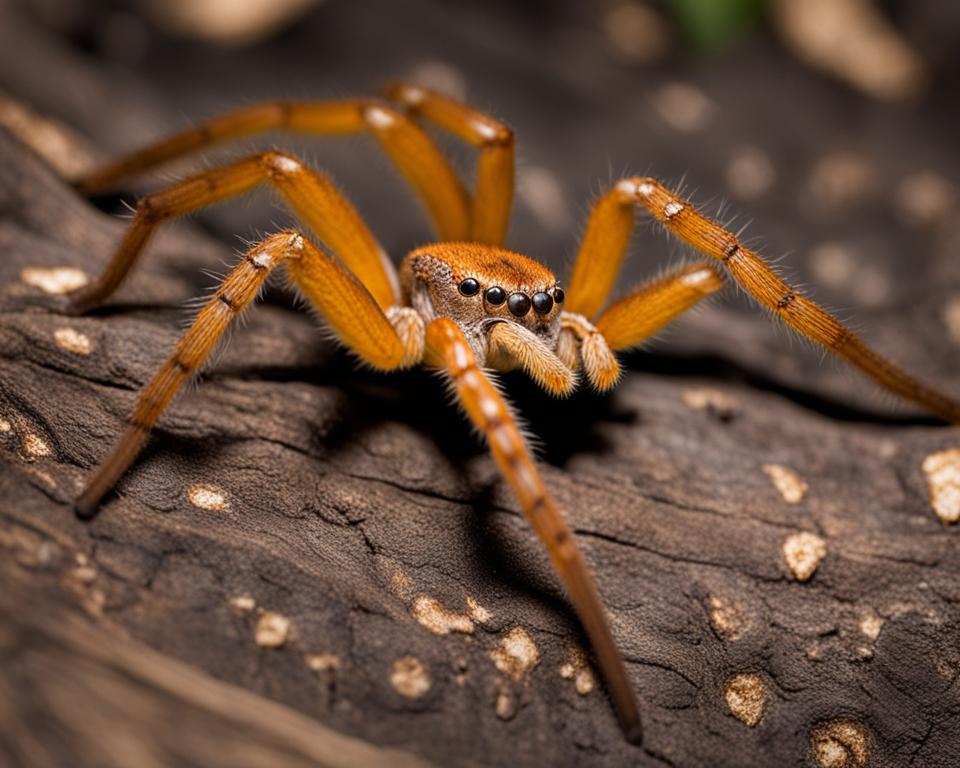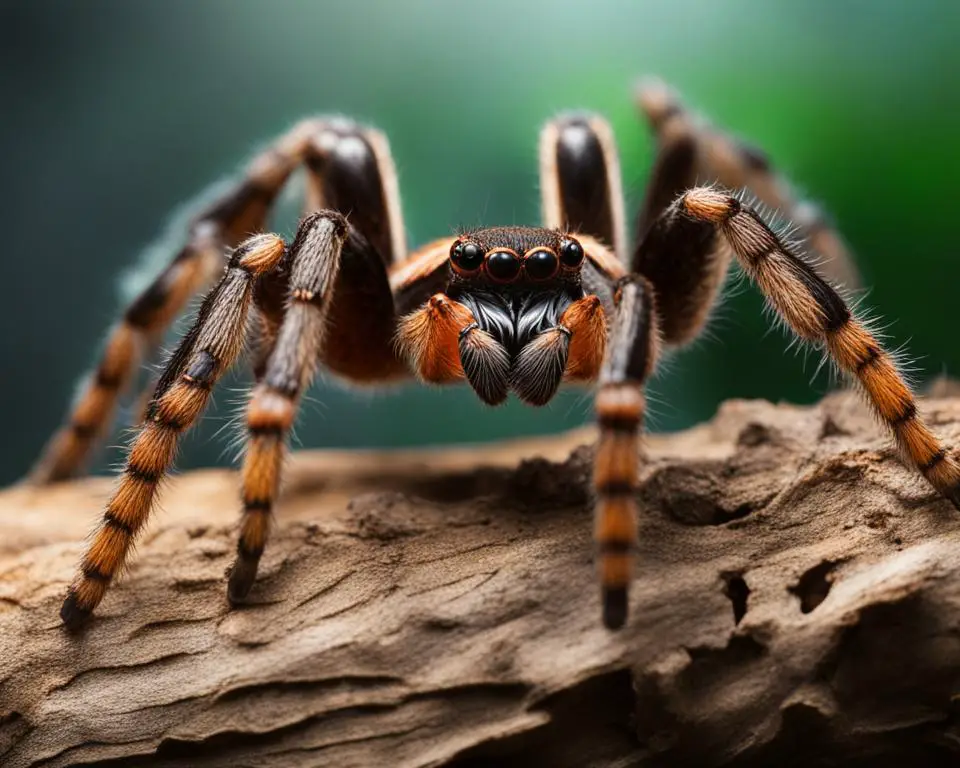If you are fascinated by the creepy crawlies of the world, chances are you have heard of huntsman spiders and tarantulas. These two spider species are often compared for their intriguing characteristics and distinct differences. In this article, we will take a closer look at the huntsman spider vs tarantula debate, exploring their physical features, hunting behaviors, and unique traits that set them apart.
Key Takeaways
- Huntsman spiders and tarantulas are two distinct spider species with different physical features and behaviors.
- Size is one of the primary differences between these two spiders, with huntsman spiders generally being larger in leg span and tarantulas in body size.
- Huntsman spiders are known for their speedy movements and lack of web-building, while tarantulas are slower-moving and build elaborate webs to trap prey.
- Some unique characteristics of huntsman spiders and tarantulas include their venomous capabilities and mating behaviors.
- Exploring the differences and similarities between these spiders can offer deeper insight into the fascinating world of arachnids.
Size Comparison: Huntsman Spider vs Tarantula
Huntsman spiders and tarantulas are both impressive arachnids, but there are some differences in their size and physical features.
Huntsman spiders are typically larger than tarantulas, with a leg span that can reach up to a foot in some species. They have long, thin legs that allow them to move rapidly and stealthily. Their body structure is thin and relatively flat, enabling them to squeeze into narrow crevices and hide from predators.
In contrast, tarantulas tend to have a chunkier body structure, with a bulky abdomen and shorter legs. While some tarantula species can be quite large, the average size range is usually between 2 to 10 inches. They have more limited mobility than huntsman spiders, and typically move more slowly, relying on their venomous bite to take down prey.
Other physical characteristics also distinguish the two species. Huntsman spiders have large, flat heads with eyes that are both acute and widely spaced. Their fangs are relatively small and non-threatening to humans. Tarantulas, on the other hand, have prominent fangs that are capable of delivering a more painful bite. They also have unique hairs that they can flick as a defense mechanism against predators.
Behavioral Contrasts: Huntsman Spiders and Tarantulas
When it comes to behavior, huntsman spiders and tarantulas exhibit some striking contrasts. For one, huntsman spiders are known for their fast movement, which they use to chase down prey rather than relying on webs. Tarantulas, on the other hand, are more sedentary and tend to wait for prey to get caught in their webs.
Huntsman spiders also have a tendency to be more active during the day, while tarantulas are typically nocturnal. Additionally, huntsman spiders are more likely to be seen in homes and buildings, while tarantulas prefer underground burrows or other secluded areas.
Another notable difference lies in their web-building habits. Huntsman spiders are not known for their web-building abilities and instead rely on their speed and agility to catch prey. Tarantulas, on the other hand, are skilled web builders and use their webs for both hunting and protection.
Overall, the behavior of huntsman spiders and tarantulas can reveal a lot about these fascinating arachnids. Their hunting tactics, movement patterns, and web-building abilities each play a crucial role in their survival and make them unique members of the spider species.

Huntsman Spiders vs Tarantulas: Behavioral Contrast Table
| Huntsman Spiders | Tarantulas | |
|---|---|---|
| Movement | Fast and agile; chase down prey | Sedentary; wait for prey to get caught in webs |
| Activity Time | More active during the day | Nocturnal |
| Habitat | Can be found in homes and buildings | Prefer underground burrows or other secluded areas |
| Web-Building | Not known for web-building abilities | Skilled web builders; use webs for hunting and protection |
Unique Characteristics of Huntsman Spiders and Tarantulas
Huntsman spiders and tarantulas possess a range of unique characteristics that distinguish them from other spider species. Let’s take a closer look at some of these interesting traits:
Physical Attributes:
Huntsman spiders have flat bodies with long and spindly legs that allow them to move quickly and easily across surfaces. They can also vary in color from light brown to gray, and their hairy legs make them easily recognizable.
Tarantulas, on the other hand, have large and hairy bodies that can grow up to 6 inches in length. They also have strong jaws and fangs, which are used to crush and kill their prey effectively.
Venomous Capabilities:
Both huntsman spiders and tarantulas are venomous, but their venom has different effects on humans. The venom of the huntsman spider primarily causes mild irritation and pain, whereas the venom of the tarantula can be more potent and cause severe symptoms such as muscle cramps and breathing difficulties.
Mating Behaviors:
Huntsman spiders have unique mating rituals where the male presents a gift to the female, which is either food or silk webbing. Tarantulas, on the other hand, have a more aggressive approach to mating, where the males usually overpower the females before copulating.
Other Distinctive Traits:
Huntsman spiders are known for their excellent vision, which enables them to detect prey and predators easily. Tarantulas, on the other hand, have the ability to regenerate limbs, which is a unique and fascinating feature.
These distinct characteristics of huntsman spiders and tarantulas make them fascinating creatures and highlight the diversity of spider species.

Conclusion
Now you have a better understanding of the differences between huntsman spiders and tarantulas. These arachnids may seem similar at first glance, but upon closer examination, they exhibit distinct characteristics that set them apart.
You learned about the size differences between these two spider species and the physical features that make them unique. Additionally, you discovered the contrasting behaviors of huntsman spiders and tarantulas, including their hunting tactics and movement patterns.
Finally, you explored the unique characteristics of these arachnids, including their venomous capabilities, mating behaviors, and physical attributes.
Overall, huntsman spiders and tarantulas are fascinating creatures with much to explore and appreciate. The next time you encounter one of these spiders, take a moment to appreciate their distinctive traits and the ways in which they contribute to our ecosystem.
FAQ
What are the key differences between huntsman spiders and tarantulas?
Huntsman spiders and tarantulas differ in size, behavior, and physical characteristics. While huntsman spiders have longer legs and a flattened body, tarantulas are larger and have a stockier build. Tarantulas also tend to be more aggressive and have urticating hairs that can cause skin irritation, while huntsman spiders are known for their fast movements and excellent hunting skills.
How big do huntsman spiders and tarantulas typically get?
Huntsman spiders can reach a leg span of up to 12 inches, while tarantulas can grow even larger, with some species having a leg span of up to 11 inches. These measurements, however, can vary depending on the species and individual specimens.
What are the hunting tactics of huntsman spiders and tarantulas?
Huntsman spiders are known for their agile and swift movements. They actively hunt their prey, relying on their excellent vision and speed to catch insects and other small creatures. On the other hand, tarantulas are ambush predators. They typically create a burrow or web and wait for their prey to come near before striking with their venomous bite.
Do huntsman spiders and tarantulas build webs?
Huntsman spiders are not known for building webs. Instead, they rely on their hunting skills and quick movements to catch their prey. Tarantulas, however, are skilled web-builders. They spin silk to create burrows, trap lines, and elaborate webs that they use for hunting or to protect their eggs.
Are huntsman spiders and tarantulas venomous?
Both huntsman spiders and tarantulas are venomous, but their venom is generally not considered dangerous to humans. Tarantula venom is typically used to immobilize their prey, while huntsman spiders have venom that aids in digestion. Bites from either species may cause mild pain, swelling, or discomfort, similar to a bee sting.
